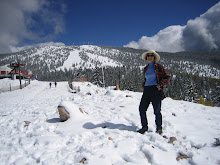
March 8
Thursday
The highlight of today is our trip to the mining town of Panuco. Leaving early in the morning, we enjoy a sunlit view of the aqueduct that borders the older section of Zacatecas. We drive by “La Bufa,” the famous hill overlooking the city. We pass El Bracho, a small church dating back to 1549. Hal informs us that this is where Zacatecas really began.
Veering northeast from El Braco and entering an area named Veta Grande, we wind our way uphill to Panuco. On one of the hills, we come to a fortress adorned with a moon and scimitar, apparently a structure used in reenactments of the battle of the Moors and the Christians. This dramatization, presented by townspeople, depicts the Christians’ victory over the Moors. It is staged yearly, from June 24 through 26. We get out briefly to look around. A caretaker is walking about the fortress grounds. He tells us that we’re the first group that’s ever come to the site.
The bus continues on to Panuco. We pile out and gather on the plaza with a local historian named Maria. The Plaza is being remodeled , the surrounding gardens spruced up. Maria tells us that Panuco’s church was the most important in the 17th century. We step inside, gazing upon a St. John’s pendant given by the Vatican, seven crosses representing forms of Christ during Holy Week.
Leaving the village plaza, we see public buildings donated by a philanthropist named Martin de Zavata. His name is everywhere, including the facade of a bright orange public library. Stepping inside, we meet the librarian. I ask him if he has any books by Rodolfo Anaya. No, but he does have an American connection. He opens a desk drawer and pulls out a letter written by my friend Delores Pong, a Santa Fe author.
We hike uphill, passing an elementary school and a small housing development, and finally reach what remains of the hacienda of Cristobal Onate. Cristobal, the father of Juan, was the founder of Zacatecas. There is no record that Juan de Onate was actually born in Panuco, but there is little doubt that he grew up in the hacienda.
The remains of the hacienda, which was built around 1548, and the adjoining mines sprawl over a vast area. For several hours, we explore the rugged terrain. I listen to occasional talks by our three guides Maria, Hal and Luis. Maria is a local historian who speaks only Spanish. I am reminded of my vow to refresh and expand my knowledge of that useful language.
The Panuco site is the first mine that started producing impressive quantities of silver. Cristobal Onate, the landowner, fathered six children - four boys and two girls. After Cristobal died, Juan was raised by a relative, probably an uncle. Juan de Onate grew up to be a miner but early in his adult years, he started expeditions to the north.
Juan de Onate’s allegiance was to Spain: he promised he would not perform any actions against the crown. At the height of his career, he owned 7,000 cattle, oversaw 130 families, and commanded 200 soldiers. By the 1800s, the Onate hacienda was mostly abandoned, with just a couple female relatives living there. The property and its crumbling walls, scene of such power and wealth, is now owned by the government of Mexico. Administered by the education department, the land is now rented out for farm uses, including the storage of animal fodder.
Next to the remains of the Onate family chapel,I stand in the sun, refreshed by a gentle breeze. Further uphill, a herd of bleating goats passes through, their bells tinkling. Alongside, a goat herder prods them along. One of the silver processing pits is the topic of a technical lecture by Hal, who explains the two methods of silver processing. Just one step in the refinement of four tons of silver ore took six weeks and large amounts of water, salt and mercury. The entire process could take four years. Nearby rivers filled the acequias and provided ample water for processing the mine’s vast quantities of silver. Medina, an entrepreneur of the time, brought the newest mining techniques to Panuco from Germany. Panuco’s mines far surpassed others in using “modern” methods.
Leaving Panuco, we drive back to Zacatecas for lunch at the hotel and then an afternoon free to explore the town. There is far too much in Zacatecas to see in just a couple afternoons. Even a week would barely suffice. Deciding to put La Bufa and the mine off for another visit, I opt to see the famous mask collection at Museo Rafael Coronel. The setting is an imposing stone Franciscan monastery, now used to serve art. It contained room after room of masks from all over Mexico, including images of military men, all manner of native tribes, Cristianos and Moors (from the Pastelores commemorations). There is a veritable multitude of devils and demons as well as animal faces. Truly an incredible display!
In the evening, most of our group stroll to the elegant Quinta Real Hotel for dinner. Perched next to the aqueduct, the bright orange buildings are surrounded by beautifully groomed gardens. We enjoy drinks in the bar, which looks out on a bull ring. No bulls there these days. Instead, the bull ring is used for special events such as weddings and receptions. Inez and I each try a different Mexican fish; both are delicious. The Quinta Real’s interior is by far the most elegant on our trip. I imagine coming back in another lifetime to















